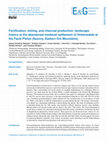Papers by Mathias Bertuch
Geopedology and Landscape Development Research Series (GeoRS) 10, 2021
Tolksdorf, Johann Friedrich/Schubert, Matthias/Schröder, Frank/Bertuch, Mathias/Heinrichsen, Anna... more Tolksdorf, Johann Friedrich/Schubert, Matthias/Schröder, Frank/Bertuch, Mathias/Heinrichsen, Anna 2021: Meilerplätze im Erzgebirge – Erfassung mittels LiDAR und Einbeziehung dieser Quellengattung in der Montanarchäologie. In: F. Hirsch/A. Raab/ T. Raab (Hrsg.), Beiträge zur Landnutzungsgeschichte in der Niederlausitz und im Erzgebirge. Geopedology and Landscape Development Research Series (GeoRS) 10 (Cottbus 2021) 82-91, doi 10.26127/BTUOpen-5388
In: R. Smolnik (Hrsg.), Ausgrabungen in Sachsen 6. Arbeits- u. Forschber. sächs. Bodendenkmalpfl.... more In: R. Smolnik (Hrsg.), Ausgrabungen in Sachsen 6. Arbeits- u. Forschber. sächs. Bodendenkmalpfl. Beih. 33 (Dresden 2018) 248–265.

E&G Quaternary Science Journal, 2019
Geoarchaeological reconstructions of land-use changes may help to reveal driving cultural factors... more Geoarchaeological reconstructions of land-use changes may help to reveal driving cultural factors and incentives behind these processes and relate them to supra-regional economic and political developments.
This is particularly true in the context of complete abandonment of a settlement. Here we present a case study from the site of Faule Pfütze, a small catchment in the Eastern Ore Mountains (Saxony). The historical record of this site is confined to the report of a settlement called Hohenwalde in 1404 CE and two later references to the then-abandoned settlement in 1492 and 1524 CE in this area. Combined geoarchaeological studies allowed for the reconstruction of several phases of land use. While a first phase of alluvial sedimentation occurred during the late 12th century, archaeological evidence for a permanent settlement is absent during this period. The onset of settlement activity is identified during the late 14th century and included a hitherto unknown massive stone building. Mining features are present nearby and are dated to the early 15th century. The local palynological
record shows evidence for reforestation during the mid 15th century and thereby corroborates the time of abandonment indicated by written sources. These processes are discussed in the context of a local
political conflict (Dohna Feud) leading to the redistribution of properties and the development of a mining economy during this time. Later land use from the mid 16th century onwards appears restricted to charcoal production, probably in the context of smelting works operating in nearby Schmiedeberg as indicated by rising lead concentrations in the alluvial record.
Thesis Chapters by Mathias Bertuch
Conference Presentations by Mathias Bertuch
Fließtext Rotis Sans Serif 45 Light Hervorhebung Rotis Sans Serif 65 Bold Präzisierung archäologi... more Fließtext Rotis Sans Serif 45 Light Hervorhebung Rotis Sans Serif 65 Bold Präzisierung archäologischer relevanzzonen im Einzugsbereich der Roten Weißeritz/Osterzgebirge Karte des Arbeitsgebietes um Dippoldiswalde mit den von Baumaßnahmen betroffenen Bächen und Arealen Eindrücke der Bauarbeiten und Situationen vor Ort (von links nach rechts): Reichstädt, Ausbau des Röthaer Baches; Reichstädt, Zisternenneubau; Schmiedeberg, Mundloch am ehem. Mühlgraben; Reichstädt, Brückenneubau an der Buschmühle; Schmiedeberg, Begehung des Stollns am ehemaligen Mühlgraben











Uploads
Papers by Mathias Bertuch
This is particularly true in the context of complete abandonment of a settlement. Here we present a case study from the site of Faule Pfütze, a small catchment in the Eastern Ore Mountains (Saxony). The historical record of this site is confined to the report of a settlement called Hohenwalde in 1404 CE and two later references to the then-abandoned settlement in 1492 and 1524 CE in this area. Combined geoarchaeological studies allowed for the reconstruction of several phases of land use. While a first phase of alluvial sedimentation occurred during the late 12th century, archaeological evidence for a permanent settlement is absent during this period. The onset of settlement activity is identified during the late 14th century and included a hitherto unknown massive stone building. Mining features are present nearby and are dated to the early 15th century. The local palynological
record shows evidence for reforestation during the mid 15th century and thereby corroborates the time of abandonment indicated by written sources. These processes are discussed in the context of a local
political conflict (Dohna Feud) leading to the redistribution of properties and the development of a mining economy during this time. Later land use from the mid 16th century onwards appears restricted to charcoal production, probably in the context of smelting works operating in nearby Schmiedeberg as indicated by rising lead concentrations in the alluvial record.
Thesis Chapters by Mathias Bertuch
Conference Presentations by Mathias Bertuch
This is particularly true in the context of complete abandonment of a settlement. Here we present a case study from the site of Faule Pfütze, a small catchment in the Eastern Ore Mountains (Saxony). The historical record of this site is confined to the report of a settlement called Hohenwalde in 1404 CE and two later references to the then-abandoned settlement in 1492 and 1524 CE in this area. Combined geoarchaeological studies allowed for the reconstruction of several phases of land use. While a first phase of alluvial sedimentation occurred during the late 12th century, archaeological evidence for a permanent settlement is absent during this period. The onset of settlement activity is identified during the late 14th century and included a hitherto unknown massive stone building. Mining features are present nearby and are dated to the early 15th century. The local palynological
record shows evidence for reforestation during the mid 15th century and thereby corroborates the time of abandonment indicated by written sources. These processes are discussed in the context of a local
political conflict (Dohna Feud) leading to the redistribution of properties and the development of a mining economy during this time. Later land use from the mid 16th century onwards appears restricted to charcoal production, probably in the context of smelting works operating in nearby Schmiedeberg as indicated by rising lead concentrations in the alluvial record.